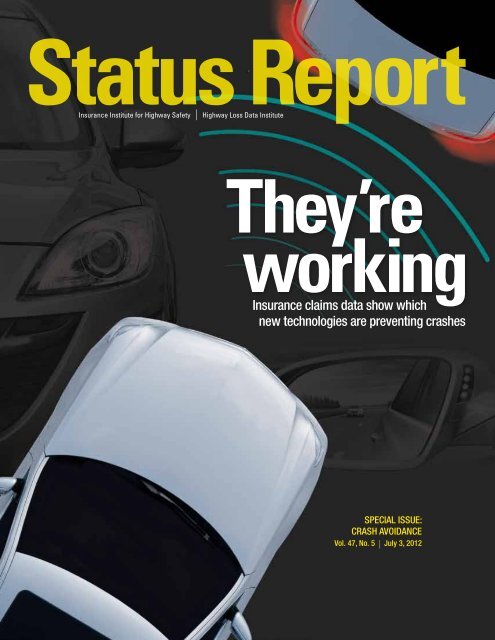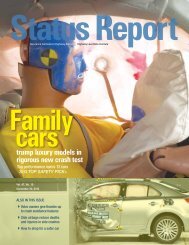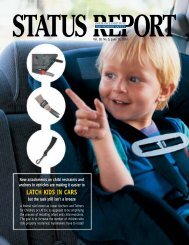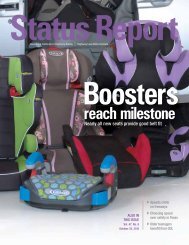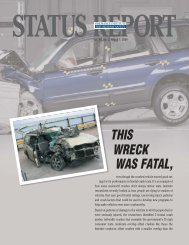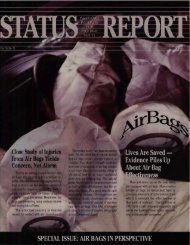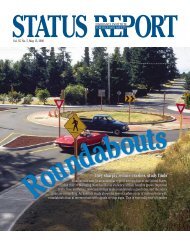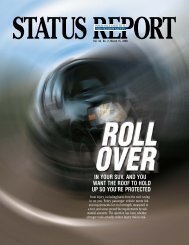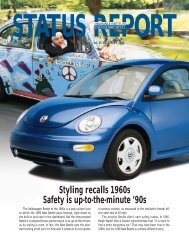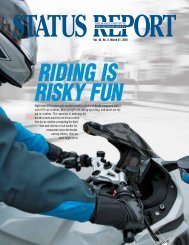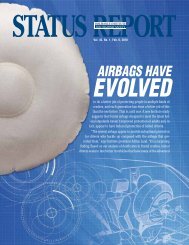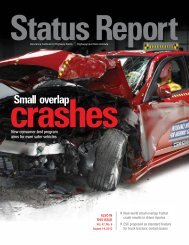IIHS Status Report newsletter, Vol. 47, No. 5, July 3, 2012
IIHS Status Report newsletter, Vol. 47, No. 5, July 3, 2012
IIHS Status Report newsletter, Vol. 47, No. 5, July 3, 2012
You also want an ePaper? Increase the reach of your titles
YUMPU automatically turns print PDFs into web optimized ePapers that Google loves.
<strong>Status</strong> <strong>Report</strong>Insurance Institute for Highway Safety | Highway Loss Data InstituteThey’reworkingInsurance claims data show whichnew technologies are preventing crashesspecial issue:crash avoidance<strong>Vol</strong>. <strong>47</strong>, <strong>No</strong>. 5 | <strong>July</strong> 3, <strong>2012</strong>
An early crop of advanced crashavoidance technologies includessome clear success stories when itcomes to preventing crashes, insuranceclaim analyses show.Forward collision avoidance systems,particularly those that can brake autonomously,along with adaptive headlights,which shift direction as the driver steers,show the biggest crash reductions in thestudies by the Highway Loss Data Institute(HLDI). One feature, lane departure warning,appears to hurt, rather than help,though it’s not clear why, and other systemsaren’t showing clear effects on crash patternsyet.“As more automakers offer advancedtechnologies on their vehicles, insurancedata provide an early glimpse of howthese features perform in the real world,”says Matt Moore, HLDI vice president.“So far, forward collision technology is reducingclaims, particularly for damage toother vehicles, and adaptive headlights arehaving an even bigger impact than we hadanticipated.”Last year, HLDI reported a reduction inclaims from <strong>Vol</strong>vo’s City Safety, a forwardcollision avoidance system that applies thebrakes automatically to prevent or mitigatelow-speed front-to-rear collisions. <strong>Vol</strong>voXC60s with standard City Safety had fewerclaims than other midsize luxury SUVs andother <strong>Vol</strong>vos without the feature (see<strong>Status</strong> <strong>Report</strong>, <strong>July</strong> 19, 2011; on the web atiihs.org). <strong>No</strong>w HLDI has data on a widergroup of features, including some thatcould have an impact on more seriouscrashes than the low-speed fender-bendersprevented by City Safety.Earlier research by the Insurance Institutefor Highway Safety estimated that if everyvehicle on the road were equipped withfour types of crash avoidance features —forward collision warning, lane departurewarning, blind spot detection and adaptiveheadlights — nearly a third of all crashescould potentially be prevented or mitigated(see <strong>Status</strong> <strong>Report</strong>, May 20, 2010). That estimateassumes that the systems work exactlyas intended and that drivers react correctlyto warnings, so it’s not surprising that so farthe measured benefits from these systemstend to be more modest.HLDI analysts looked at how each featureaffected claim frequency under property-10-10-20-10-20-302010-10-20Forward collision avoidancePercent differences in claim frequency with and withoutAcurawithauto brakeCollisionMercedeswithauto brakeProperty damage liabilityBodily injury liabilityMercedeswithoutauto brake■ Medical payment■ Personal injury protectionstatistically significant<strong>Vol</strong>vowithauto brake 1<strong>Vol</strong>vowithoutauto brake1All <strong>Vol</strong>vo vehicles with auto brake also have lane departure warning and fatigue warning.Medical payment and personal injury protection both cover occupants of the insured vehicle. Personal injuryprotection is sold in the 17 states with no-fault insurance systems and covers injuries regardless of who is at fault.2 |<strong>Status</strong> <strong>Report</strong> — <strong>Vol</strong>. <strong>47</strong>, <strong>No</strong>. 5
damage liability (PDL) insurance, which coversdamage to another vehicle caused by the insuredvehicle, and collision insurance, which coversdamage to the insured vehicle. They also looked atclaims for injuries under three coverage types. Injuriesto other road users, including occupants ofother vehicles and pedestrians, are covered by bodilyinjury liability insurance, while injuries to occupantsof the insured vehicle are covered by either medicalpayment insurance or personal injury protection,depending on the state.Claim frequency is the number of claims relativeto the number of insured vehicle years. An insuredvehicle year is one vehicle insured for one year, twovehicles for six months, etc. The model years of thevehicles included ranged from 2000 to 2011, dependingon when an automaker introduced a feature.Insurance data through August 2011 were used.The crash avoidance systems studied were all offeredas optional equipment. Most of the data camefrom luxury brands, the first to offer such features,Forward collision avoidancesystems, particularly those thatbrake autonomously, show someof the biggest crash reductions.Adaptive headlights also aresurprisingly effective.though more and more nonluxury vehicles also offerthem now. The automakers supplied HLDI withidentification numbers of vehicles that had eachfeature, allowing HLDI to compare the insurancerecords for those vehicles with the same modelswithout the feature.In each analysis, HLDI controlled for a number offactors that could influence claim rates, includingdriver age and gender, garaging state and collisiondeductible.Acura’s autonomous braking system was one ofseveral advanced crash avoidance technologiesdemonstrated last year on the track at the Institute’s Vehicle Research Center.The driver of the silver vehicle, an Acura ZDX, followed the moving target(mounted to the black SUV), coming close enough to activate the auto brake.Forward collision avoidanceForward collision warning systems alert the driverif the vehicle is gaining on the traffic ahead of it soquickly that it is about to crash. Some of these systemsalso are equipped with autonomous braking,meaning the vehicle will brake on its own if thedriver doesn’t respond in time. These systems operateat higher speeds than City Safety, which doesn’tprovide any warning before it brakes.Claims for the front-to-rear collisions that forwardcollision avoidance systems are meant to address are<strong>July</strong> 3, <strong>2012</strong> |3
-10-1010-10-10-20-30Adaptive headlightsPercent differences in claim frequency with and withoutAcura Mazda Mercedes <strong>Vol</strong>voCollisionPropertydamage liabilityBodilyinjuryliabilitystatistically significant■ Medicalpayment■ PersonalinjuryprotectionAdaptive headlights appear tobe helping in more situationsthan previously anticipated,though it’s not yet clear why.common under PDL coverage, andHLDI found the technology reducesPDL claim frequency. Claim frequencyunder collision coverage, which includesmany of the same crashes thatfall under property damage liability butalso a lot of single-vehicle crashes thatthese systems are not designed toaddress, also was reduced but by asmaller amount.HLDI examined forward collisionsystems offered on Acura, Mercedes-Benz and <strong>Vol</strong>vo vehicles. PDL frequenciesfor Acura and Mercedesmodels were 14 percent lower whenthe vehicles were equipped withforward collision warning with autonomousbraking than when they weren’t.<strong>Vol</strong>vo’s autonomous braking systemalso reduced the claim rate 10 percent,but that finding wasn’t statisticallysignificant. The <strong>Vol</strong>vo system comesbundled with lane departure warningand fatigue warning, so that figure maybe affected by those features as well.Front-to-rear collisions also resultin many claims for minor injuries likewhiplash and back sprains to theoccupants of the struck vehicle, and allthe systems reduced claims underbodily injury liability insurance. Althoughthose reductions weren’t statisticallysignificant, they are encouragingand consistent with the observed reductionin PDL claims. For Acura andMercedes vehicles with auto brake,claim frequency for injuries to the insuredvehicle’s occupants tended to belower as well, while results were the oppositefor <strong>Vol</strong>vo. <strong>No</strong>ne of these resultswas statistically significant.HLDI also examined separate Mercedesand <strong>Vol</strong>vo systems that don’tinclude autonomous braking. Theseappear to lower crash rates, too, butnot to the same extent as the versionsthat do include it. These systems probablyhave more modest effects on PDLclaims because they rely on drivers torespond appropriately to warnings andcan’t directly avoid crashes. There alsoare other differences between systemsthat do and don’t have auto brake. Forexample, <strong>Vol</strong>vo’s system without autobrake is functional only at speeds over20 mph, while the version with autobrake starts working at 3 mph. Thesesystems also seem to reduce the frequencyof bodily injury claims forother road users, but evidence is mixedfor injury claims by the occupantsof the insured vehicle. More data areneeded to know the effect for certain.Adaptive headlightsAdaptive headlights respond to steeringinput to help a driver see arounda curve in the dark. The headlights’horizontal aim is adjusted based onthe speed of the vehicle, direction ofthe steering wheel and other factors sothat the lights are directed where thevehicle is heading.When the Institute estimated thepotential of this technology in 2010,researchers expected it could reducesingle-vehicle run-off-road crashes,which would be reflected in collisionclaim frequency. However, HLDI’sanalysis of adaptive headlights offeredby Acura, Mazda, Mercedes and <strong>Vol</strong>vofound that of the various coveragetypes, collision had the smallest claimfrequency reductions. The results didshow decreases in injury claims for theinsured vehicles — some of them large— in support of earlier expectations.What is surprising is that vehicleswith adaptive headlights had reductionsin property damage and bodilyinjury liability claims, which both involveother road users. With the exceptionof Acura, bodily injury liabilityfrequencies fell 10 percent or more, andall four manufacturers saw decreasesin PDL frequencies ranging from 5 to10 percent. This is a dramatic result,given that only about 7 percent of police-reportedcrashes occur between 9p.m. and 6 a.m. and involve more thanone vehicle. An even smaller percentageare multiple-vehicle, nighttimecrashes occurring on a curve, whereadaptive headlights would be expectedto have an effect. It’s possible that otherdifferences besides steerability betweenthe adaptive headlights and conventionalones, for example, in brightness or range,may have played a role in reducingcrashes with other vehicles.“All four adaptive headlight systemswe looked at show benefits for most4 |<strong>Status</strong> <strong>Report</strong> — <strong>Vol</strong>. <strong>47</strong>, <strong>No</strong>. 5
Innovationsaim to stave off crash threats from all sidesAutomakers are deploying new technologyon all sides of vehicles and inevery direction to prevent crashes orlessen their severity.The crash avoidance features highlightedin this <strong>Status</strong> <strong>Report</strong> — forward collisionavoidance, adaptive headlights and lanedeparture warning — are among the mostcommon of these high-tech detection, warningand intervention devices on the marketso far. Other features that the Highway LossData Institute (HLDI) is gathering data oninclude blind spot detection, park assist andbackup cameras. All these systems are beginningto make their way into mainstreamvehicles, beyond the luxury models wherethey started out. For example, one of the topsellingvehicles, the Toyota Camry, comeswith optional blind spot detection for <strong>2012</strong>.The current Ford Taurus has optionalforward collision warning and blind spotdetection. Chevrolet, Dodge and Chrysleralso are among the brands offering advancedtechnology.But the list of high-tech features on themarket or soon to be available is muchlonger. Other examples include crosstraffic alert, which warns a driver if trafficis about to enter the vehicle’s path fromthe side; curve speed warning, which usesGPS and speed information to determine ifthe vehicle is about to take a curve too fast;and fatigue warning, which tracks steeringand other driver behaviors to determine ifthe driver is inattentive or in danger of fallingasleep. Night vision assist uses infraredimaging to produce an enhanced viewof the road ahead, projecting objects on adisplay before they are visible through thewindshield.Side impact detection, which is not yeton the market, is meant to detect an imminentside collision. The advance warningallows for the deployment of larger airbags,which take longer to inflate but can betterprotect occupants. Similarly, rear collisiondetection gives the vehicle a chance toadjust seats and head restraints and takeother measures to prepare for a crash.Some relatively common features arebeing further enhanced. For example, a fewforward collision warning systems canrecognize a pedestrian and predict whetherthe person will cross the vehicle’s path.These pedestrian detection systems couldbe expanded in the future to recognizeanimals or bicyclists.Many park assist systems provide guidanceto help the driver fit into a spot, butsome vehicles are actually self-parking andcan maneuver into a spot automatically,though the driver still controls the throttle.Lane departure prevention goes a stepfurther than lane departure warning bygently guiding the vehicle back into its laneposition if it begins to stray.Once these other features have beenaround long enough in enough vehicles,HLDI may be able to examine their effecton claims, too. However, it’s becoming moredifficult to tease out the effects of individualfeatures because they are increasinglybundled together. This makes it particularlyimportant to develop tests that can evaluatethe performance of each feature. The InsuranceInstitute for Highway Safety recentlylaunched such work at its Vehicle ResearchCenter. Using stationary and moving targets,as well as a pedestrian rig that “walks”Forward collision avoidanceCurve speed warningAdaptive headlights Night vision assistCrosstrafficalertLanedeparturewarning/preventionBlindspotdetectionFatiguewarningBackup cameraRear collision detectionCross traffic alertParkassistSideimpactdetectionSelf-parkingacross a vehicle’s path, researchers havebegun to evaluate how some crash avoidancefeatures perform. In the future, such experimentswill provide valuable information forconsumers. They also could help automakersas they decide which of these many technologiesto pursue further. n<strong>July</strong> 3, <strong>2012</strong> |5
Lane departurewarning systemsPercent differences in claimfrequency with and without10Buick 1 Mercedes <strong>Vol</strong>vo 2Collision-1010-10Propertydamageliability-10Bodilyinjuryliability-20Lane departurewarning may havethe potential to reduce fatalcrashes, but so far no benefits from thisfeature have shown up in insurance data.-3010080604020■■MedicalpaymentPersonalinjuryprotection1All Buick vehicles with lane departure warning also have blindspot detection.2All <strong>Vol</strong>vo vehicles with lane departure warning also have forwardcollision warning with auto brake and fatigue warning.The cost of crashesFor every feature, in addition to claim frequency,HLDI also looked at the average paymentper claim, known as claim severity.Claim severity for collision losses increasedwith most of the crash avoidance features.This increase wasn’t unexpected becausemany of these technologies eliminate lesssevere crashes first, meaning the ones thatremain are on average more expensive.However, in some cases, collision claim severitywent up sharply even when frequency didn’tgo down or fell only slightly. For example, withMercedes’ basic forward collision warningsystem, the frequency of collision claimsinched down 3 percent, but severity shot upby $813. That’s probably because the priceyradar sensors used by the system are mountedright behind the grille and thus are vulnerableto damage in a crash. The same issue appliesto adaptive headlights, which are moreexpensive than regular headlights.In practical terms, this means that even atechnology that improves safety won’t necessarilyreduce insurance costs, which reflectboth claim frequency and claim severity. n6 |<strong>Status</strong> <strong>Report</strong> — <strong>Vol</strong>. <strong>47</strong>, <strong>No</strong>. 5
insurance coverages, and many of these estimated reductions arestatistically significant,” Moore says. “These lights appear to help inmore situations than we anticipated, though we don’t yet know why.”Lane departure warningIn the Institute’s 2010 analysis of the potential of crash avoidance technologies,lane departure warning was one of the stars. Researchersestimated it could prevent or mitigate up to 7,529 fatal crashes if allvehicles had it — the biggest potential fatal crash reduction of any ofthe features studied, primarily due to expected reductions in singlevehiclerun-off-road crashes. In the HLDI study, however, lanedeparture warning systems from Buick and Mercedes were associatedwith higher claim rates under both collision and PDL coverages.Only <strong>Vol</strong>vo’s vehicles showed a reduction in claim rates under thesecoverages, as well as bodily injury liability, but <strong>Vol</strong>vo’s system is bundledwith forward collision warning with autonomous braking,which more likely accounts for the estimated benefits. In addition,claim frequency for injuries to occupants of the insured vehicle washigher for vehicles with lane departure warning, although no resultswere statistically significant.<strong>Vol</strong>vo isn’t the only vehicle make whose lane departure warningcomes with another feature intended to prevent crashes. Buick’ssystem is bundled with blind spot detection. That makes the lack ofclaim reductions for Buick even more perplexing.Part of the disconnect between these results and the Institute’sestimates of the feature’s potential probably has to do with the factthat crashes in which vehicles drift off the road aren’t common, eventhough they account for a large proportion of fatal crashes. This wasreflected in the Institute study as well, which found that lane departurewarning would be irrelevant to about 97 percent of policereportedcrashes. The HLDI results also may point to problems withthe current technology, which relies on cameras to track lane markingsand thus isn’t effective if the markings aren’t clearly visible.“Lane departure warning may end up saving lives down theroad, but so far these particular versions aren’t preventing insuranceclaims,” Moore says. “It may be that drivers are getting toomany false alarms, which could make them tune out the warningsor turn them off completely. Of course, that doesn’t explain why thesystems seem to increase claim rates, but we need to gather moredata to see if that’s truly happening.”Annoyance and false alarms were issues for Infiniti and <strong>Vol</strong>voowners surveyed by the Institute about crash avoidance features in2009. Forty-three percent of <strong>Vol</strong>vo owners and 46 percent of Infinitiowners reported receiving false or unnecessary lane departurealerts. Twenty-five percent of <strong>Vol</strong>vo owners and 41 percent of Infinitiowners said the lane departure warning system was annoying (see<strong>Status</strong> <strong>Report</strong>, <strong>No</strong>v. 18, 2009). Although more than two-thirds ofowners said they always kept the systems on, false alarms couldcause drivers to ignore the warnings or react to them more slowly.HLDI has yet to look at lane departure prevention, which, unlikea warning system, actively keeps a vehicle in its lane and could havea different impact on claims.“Just as forward collision warning systems that include autonomousbraking cut crashes more sharply than those that don’t, lanedeparture prevention systems that don’t rely on a driver’s responsemay hold more promise than the systems HLDI has looked at sofar,” says David Zuby, the Institute’s chief research officer. “The lanedeparture prevention systems are newer and less common than thewarning systems, so we’ll have to wait for more data before we canlook for a pattern there.”Other technologiesThis <strong>Status</strong> <strong>Report</strong> focuses on the three crash avoidance technologiesfor which HLDI has the most information: forward collision avoidance,adaptive headlights and lane departure warning. The HLDIreports on which the conclusions are based also provide some resultsfor additional technologies. Some of these results are promising: Forexample, Buick’s rear park assist system appears to reduce PDLclaims dramatically. However, the data on these features acrossbrands is inconsistent. As more information becomes available onthese technologies, <strong>Status</strong> <strong>Report</strong> will provide further summaries.“These analyses are the first to estimate real-world effectivenessof several crash avoidance technologies that have been filtering intothe market recently,” Zuby says. “While some results indicate theneed for further investigation, it’s clear that certain systems, suchas those that help drivers avoid collisions with the vehicle in frontor better illuminate the road ahead, can play a role in making roadssafer for everyone.” nWant to learn more?The Institute’s website has a wealth of information on crash avoidancetechnologies. New animated videos demonstrate how someof the most common features are designed to operate. Forwardcollision warning, adaptive headlights, lane departure warning,adaptive cruise control and backup cameras are all illustrated andexplained. The videos are part of an extensive Q&A on the basics ofcrash avoidance: what features exist, how they can help and whatthe future holds. You also can find information on availabilityof crash avoidance features by vehicle make and model. In addition,detailed reports from HLDI on the claim analyses described inthese pages are available for each of the five vehicle makes studied.iihs.org/crash_avoidance<strong>July</strong> 3, <strong>2012</strong> |7
<strong>Status</strong> <strong>Report</strong>Special issue:crash avoidance<strong>Vol</strong>. <strong>47</strong>, <strong>No</strong>. 5<strong>July</strong> 3, <strong>2012</strong>The Insurance Institute for Highway Safety is an independent, nonprofit scientific and educational organization dedicatedto reducing the losses — deaths, injuries and property damage — from crashes on the nation’s roads.The Highway Loss Data Institute shares and supports this mission through scientific studies of insurance data representingthe human and economic losses resulting from the ownership and operation of different types of vehicles and by publishinginsurance loss results by vehicle make and model.Both organizations are wholly supported by the following auto insurers and funding associations:1005 N Glebe RoadArlington, VA 22201 USAt 703/2<strong>47</strong>-1500f 703/2<strong>47</strong>-1588Inquiries/print subscriptions:<strong>Status</strong><strong>Report</strong>@iihs.orgCopy may be republished withattribution. Images requirepermission to use.Editor: Kim StewartWriter: Sarah KarushArt Director: Steve Ewenswww.iihs.orgiihs.org/rssyoutube.com/iihs@<strong>IIHS</strong>_autosafetym.iihs.orgThis publication is printed on recycled paper.Member groupsACE Private Risk ServicesAffirmative InsuranceAgency Insurance Company of MarylandAlfa Alliance Insurance CorporationAlfa InsuranceAllstate Insurance GroupAmerican Family Mutual InsuranceAmerican National Property and Casualty CompanyAmeriprise Auto & HomeAmica Mutual Insurance CompanyARI Insurance CompaniesAuto Club EnterprisesAuto Club GroupBankers Insurance GroupBituminous Insurance CompaniesCalifornia Casualty GroupCalifornia State Auto GroupCapital Insurance GroupChubb & SonColorado Farm Bureau Mutual Insurance CompanyConcord Group Insurance CompaniesCotton States InsuranceCOUNTRY FinancialDirect General CorporationDiscovery Insurance CompanyDriver’s Insurance GroupErie Insurance GroupEsuranceFarm Bureau Financial ServicesFarm Bureau Insurance of MichiganFarm Bureau Mutual Insurance Company of IdahoFarmers Insurance Group of CompaniesFarmers Mutual Hail Insurance Company of IowaFarmers Mutual of NebraskaFireman’s Fund Insurance CompanyFirst Acceptance CorporationFlorida Farm Bureau Insurance CompaniesFrankenmuth InsuranceGainsco InsuranceGEICO GroupGeorgia Farm Bureau Mutual Insurance CompanyGMAC Personal Lines InsuranceGrange InsuranceHallmark Insurance CompanyHanover Insurance GroupThe HartfordHaulers Insurance Company, Inc.Homeowners of America Insurance CompanyHorace Mann Insurance CompaniesICW GroupImperial Fire & Casualty Insurance CompanyIndiana Farmers Mutual Insurance CompanyInfinity Property & CasualtyKemper PreferredKentucky Farm Bureau InsuranceLiberty Mutual Insurance CompanyLouisiana Farm Bureau Mutual Insurance CompanyMaryland Automobile Insurance FundMercury Insurance GroupMetLife Auto & HomeMiddleOakMississippi Farm Bureau Casualty Insurance CompanyMMG InsuranceMutual of Enumclaw Insurance CompanyNationwideNew Jersey Manufacturers Insurance GroupNLC Insurance Companies, Inc.<strong>No</strong>dak Mutual Insurance Company<strong>No</strong>rfolk & Dedham Group<strong>No</strong>rth Carolina Farm Bureau Mutual Insurance Company<strong>No</strong>rthern Neck Insurance CompanyOld American County Mutual Fire InsuranceOregon Mutual InsurancePekin InsurancePEMCO InsurancePlymouth Rock AssuranceProgressive CorporationThe Responsive Auto Insurance CompanyRockingham GroupSafeco InsuranceSamsung Fire & Marine Insurance CompanySECURA InsuranceSentry InsuranceShelter InsuranceSompo Japan Insurance Company of AmericaSouth Carolina Farm Bureau Mutual Insurance CompanySouthern Farm Bureau Casualty Insurance CompanyState Auto Insurance CompaniesState FarmTennessee Farmers Mutual Insurance CompanyTexas Farm Bureau Insurance CompaniesTower Group CompaniesThe Travelers CompaniesUnited EducatorsUSAAViceroy Insurance CompanyVirginia Farm Bureau Mutual InsuranceWest Bend Mutual Insurance CompanyYoung America Insurance CompanyZurich <strong>No</strong>rth AmericaFunding associationsAmerican Insurance AssociationNational Association of Mutual Insurance CompaniesProperty Casualty Insurers Association of America


